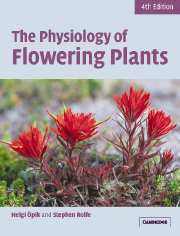Book contents
- Frontmatter
- Contents
- Preface
- Chapter 1 Introduction
- Part I Nutrition and transport
- Chapter 2 Flow of energy and carbon through the plant: photosynthesis and respiration
- Chapter 3 Water relations
- Chapter 4 Mineral nutrition
- Chapter 5 Translocation of organic compounds
- Part II Growth and development
- Appendix
- Index
- References
Chapter 4 - Mineral nutrition
Published online by Cambridge University Press: 05 June 2012
- Frontmatter
- Contents
- Preface
- Chapter 1 Introduction
- Part I Nutrition and transport
- Chapter 2 Flow of energy and carbon through the plant: photosynthesis and respiration
- Chapter 3 Water relations
- Chapter 4 Mineral nutrition
- Chapter 5 Translocation of organic compounds
- Part II Growth and development
- Appendix
- Index
- References
Summary
Introduction
Of the naturally occurring 92 elements of the periodic table, about a quarter are essential to plants. Water and CO2 provide the plant with the elements C, H and O; the remaining necessary elements are obtained by flowering plants as inorganic mineral ions, mostly from the soil solution. Water uptake and ion uptake are to some extent linked, e.g. water uptake mediated by root pressure depends on ion uptake, and the rate of ion uptake tends to increase with increasing rate of transpiration. But the uptake of mineral ions differs greatly from water uptake in that it proceeds against the free energy gradient of the ions and is dependent on metabolic energy. The transport of ions through cellular membranes is mediated by numerous membrane-bound transport proteins which enable the plant to exert considerable control and selectivity over the process. This is vital if the nutritional needs of the plant are to be satisfied. Heterotrophic organisms obtain nearly all their essential elements via plants and the element composition of plants is accordingly of major interest and importance also for human nutrition.
Essential elements
Definition: macronutrients and micronutrients
An element is classed as essential to a plant if the plant cannot complete its life cycle without it and no other element can substitute for it. The effect of the element must also be direct, i.e. it should not act by promoting the uptake of another essential element, or by retarding the absorption of a toxic one.
- Type
- Chapter
- Information
- The Physiology of Flowering Plants , pp. 100 - 132Publisher: Cambridge University PressPrint publication year: 2005



